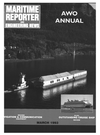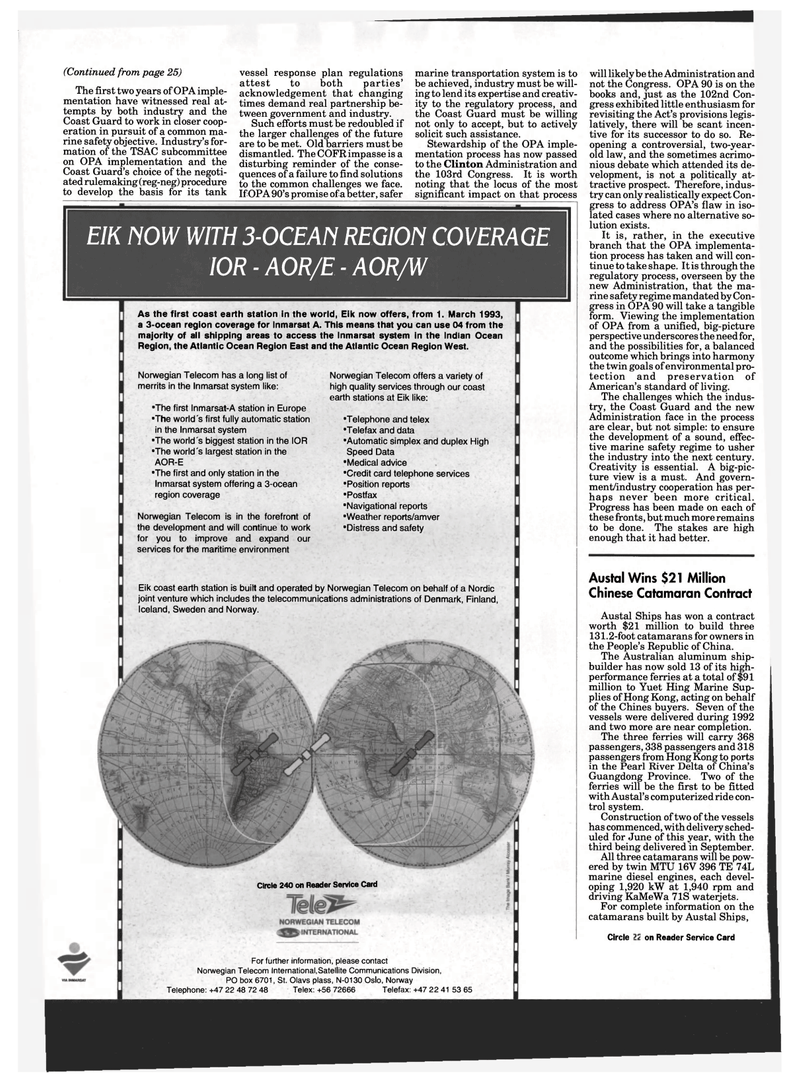
Page 24: of Maritime Reporter Magazine (March 1993)
Read this page in Pdf, Flash or Html5 edition of March 1993 Maritime Reporter Magazine
Circle 240 on Reader Service Card
For further information, please contact
Norwegian Telecom International,Satellite Communications Division,
PO box 6701, St. Olavs plass, N-0130 Oslo, Norway
Telephone: +47 22 48 72 48 Telex: +56 72666 Telefax: +47 22 41 53 65
EIK NOW WITH 3-OCEAN REGION COVERAGE
IOR • AOR/E - AOR/W will likely be the Administration and not the Congress. OPA 90 is on the books and, just as the 102nd Con- gress exhibited little enthusiasm for revisiting the Act's provisions legis- latively, there will be scant incen- tive for its successor to do so. Re- opening a controversial, two-year- old law, and the sometimes acrimo- nious debate which attended its de- velopment, is not a politically at- tractive prospect. Therefore, indus- try can only realistically expect Con- gress to address OPA's flaw in iso- lated cases where no alternative so- lution exists.
It is, rather, in the executive branch that the OPA implementa- tion process has taken and will con- tinue to take shape. It is through the regulatory process, overseen by the new Administration, that the ma- rine safety regime mandated by Con- gress in OPA 90 will take a tangible form. Viewing the implementation of OPA from a unified, big-picture perspective underscores the need for, and the possibilities for, a balanced outcome which brings into harmony the twin goals of environmental pro- tection and preservation of
American's standard of living.
The challenges which the indus- try, the Coast Guard and the new
Administration face in the process are clear, but not simple: to ensure the development of a sound, effec- tive marine safety regime to usher the industry into the next century.
Creativity is essential. A big-pic- ture view is a must. And govern- ment/industry cooperation has per- haps never been more critical.
Progress has been made on each of these fronts, but much more remains to be done. The stakes are high enough that it had better. (Continued from page 25)
The first two years of OPA imple- mentation have witnessed real at- tempts by both industry and the
Coast Guard to work in closer coop- eration in pursuit of a common ma- rine safety objective. Industry's for- mation of the TSAC subcommittee on OPA implementation and the
Coast Guard's choice of the negoti- ated rulemaking (reg-neg) procedure to develop the basis for its tank vessel response plan regulations attest to both parties' acknowledgement that changing times demand real partnership be- tween government and industry.
Such efforts must be redoubled if the larger challenges of the future are to be met. Old barriers must be dismantled. The COFR impasse is a disturbing reminder of the conse- quences of a failure to find solutions to the common challenges we face.
If OPA9Q's promise of abetter, safer marine transportation system is to be achieved, industry must be will- ing to lend its expertise and creativ- ity to the regulatory process, and the Coast Guard must be willing not only to accept, but to actively solicit such assistance.
Stewardship of the OPA imple- mentation process has now passed to the Clinton Administration and the 103rd Congress. It is worth noting that the locus of the most significant impact on that process
Austal Wins $21 Million
Chinese Catamaran Contract
Austal Ships has won a contract worth $21 million to build three 131.2-foot catamarans for owners in the People's Republic of China.
The Australian aluminum ship- builder has now sold 13 of its high- performance ferries at a total of $91 million to Yuet Hing Marine Sup- plies of Hong Kong, acting on behalf of the Chines buyers. Seven of the vessels were delivered during 1992 and two more are near completion.
The three ferries will carry 368 passengers, 338 passengers and 318 passengers from Hong Kong to ports in the Pearl River Delta of China's
Guangdong Province. Two of the ferries will be the first to be fitted with Austal's computerized ride con- trol system.
Construction of two of the vessels has commenced, with delivery sched- uled for June of this year, with the third being delivered in September.
All three catamarans will be pow- ered by twin MTU 16V 396 TE 74L marine diesel engines, each devel- oping 1,920 kW at 1,940 rpm and driving KaMeWa 7 IS waterjets.
For complete information on the catamarans built by Austal Ships,
Circle 313 on Reader Service Card
Eik coast earth station is built and operated by Norwegian Telecom on behalf of a Nordic joint venture which includes the telecommunications administrations of Denmark, Finland,
Iceland, Sweden and Norway.
As the first coast earth station in the world, Eik now offers, from 1. March 1993, a 3-ocean region coverage for Inmarsat A. This means that you can use 04 from the majority of all shipping areas to access the Inmarsat system in the Indian Ocean
Region, the Atlantic Ocean Region East and the Atlantic Ocean Region West.
Norwegian Telecom has a long list of merrits in the Inmarsat system like: •The first Inmarsat-A station in Europe •The world's first fully automatic station in the Inmarsat system •The world's biggest station in the IOR •The world's largest station in the
AOR-E •The first and only station in the
Inmarsat system offering a 3-ocean region coverage
Norwegian Telecom is in the forefront of the development and will continue to work for you to improve and expand our services for the maritime environment
Norwegian Telecom offers a variety of high quality services through our coast earth stations at Eik like: •Telephone and telex •Telefax and data •Automatic simplex and duplex High
Speed Data •Medical advice •Credit card telephone services •Position reports •Postfax •Navigational reports •Weather reports/amver •Distress and safety

 23
23

 25
25
